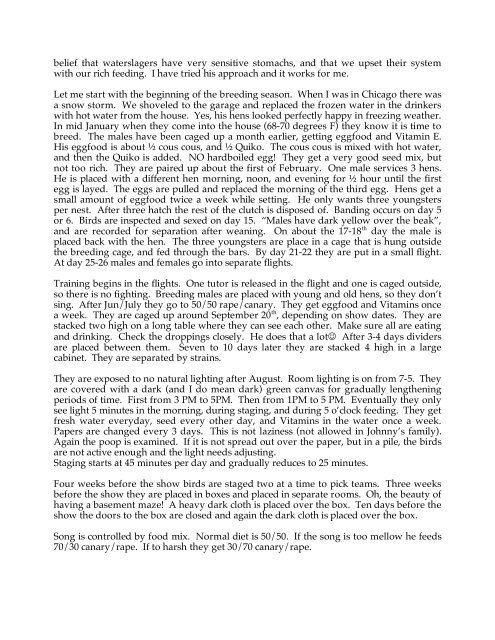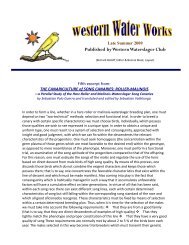Newsletter 1-06.pdf - Western Waterslager Club
Newsletter 1-06.pdf - Western Waterslager Club
Newsletter 1-06.pdf - Western Waterslager Club
Create successful ePaper yourself
Turn your PDF publications into a flip-book with our unique Google optimized e-Paper software.
elief that waterslagers have very sensitive stomachs, and that we upset their systemwith our rich feeding. I have tried his approach and it works for me.Let me start with the beginning of the breeding season. When I was in Chicago there wasa snow storm. We shoveled to the garage and replaced the frozen water in the drinkerswith hot water from the house. Yes, his hens looked perfectly happy in freezing weather.In mid January when they come into the house (68-70 degrees F) they know it is time tobreed. The males have been caged up a month earlier, getting eggfood and Vitamin E.His eggfood is about ½ cous cous, and ½ Quiko. The cous cous is mixed with hot water,and then the Quiko is added. NO hardboiled egg! They get a very good seed mix, butnot too rich. They are paired up about the first of February. One male services 3 hens.He is placed with a different hen morning, noon, and evening for ½ hour until the firstegg is layed. The eggs are pulled and replaced the morning of the third egg. Hens get asmall amount of eggfood twice a week while setting. He only wants three youngstersper nest. After three hatch the rest of the clutch is disposed of. Banding occurs on day 5or 6. Birds are inspected and sexed on day 15. “Males have dark yellow over the beak”,and are recorded for separation after weaning. On about the 17-18 th day the male isplaced back with the hen. The three youngsters are place in a cage that is hung outsidethe breeding cage, and fed through the bars. By day 21-22 they are put in a small flight.At day 25-26 males and females go into separate flights.Training begins in the flights. One tutor is released in the flight and one is caged outside,so there is no fighting. Breeding males are placed with young and old hens, so they don’tsing. After Jun/July they go to 50/50 rape/canary. They get eggfood and Vitamins oncea week. They are caged up around September 20 th , depending on show dates. They arestacked two high on a long table where they can see each other. Make sure all are eatingand drinking. Check the droppings closely. He does that a lot After 3-4 days dividersare placed between them. Seven to 10 days later they are stacked 4 high in a largecabinet. They are separated by strains.They are exposed to no natural lighting after August. Room lighting is on from 7-5. Theyare covered with a dark (and I do mean dark) green canvas for gradually lengtheningperiods of time. First from 3 PM to 5PM. Then from 1PM to 5 PM. Eventually they onlysee light 5 minutes in the morning, during staging, and during 5 o’clock feeding. They getfresh water everyday, seed every other day, and Vitamins in the water once a week.Papers are changed every 3 days. This is not laziness (not allowed in Johnny’s family).Again the poop is examined. If it is not spread out over the paper, but in a pile, the birdsare not active enough and the light needs adjusting.Staging starts at 45 minutes per day and gradually reduces to 25 minutes.Four weeks before the show birds are staged two at a time to pick teams. Three weeksbefore the show they are placed in boxes and placed in separate rooms. Oh, the beauty ofhaving a basement maze! A heavy dark cloth is placed over the box. Ten days before theshow the doors to the box are closed and again the dark cloth is placed over the box.Song is controlled by food mix. Normal diet is 50/50. If the song is too mellow he feeds70/30 canary/rape. If to harsh they get 30/70 canary/rape.



